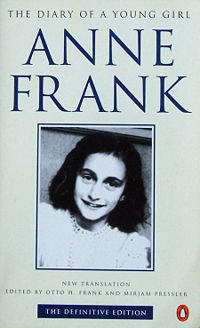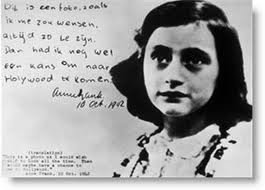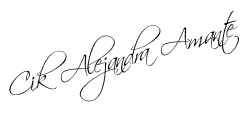~ ANNE FRANK ~
Annelies Marie "Anne" Frank (12 Jun 1929 – Februari/Mac 1945) adalah seorang gadis Yahudi yang menulis sebuah buku harian ketika beliau bersembunyi bersama keluarga dan empat temannya di Amsterdam semasa pendudukan Nazi di Belanda pada Perang Dunia II. Setelah bersembunyi selama dua tahun, mereka dikhianati dan mereka dibawa ke kem konsentrasi yang mengakibatkan kesemua mereka mati kecuali Otto, ayah Anne. Otto kembali ke Amsterdam dan dia menemui buku harian anaknya. Kerana yakin akan uniknya catatan tersebut, Otto berusaha untuk menerbitkannya.
Buku harian tersebut diberikan kepada Anne pada ulang tahunnya yang ketiga belas dan mencatat rentetan peristiwa-peristiwa kehidupan Anne dari 12 Jun 1942 hingga catatan terakhir pada 1 Ogos 1944. Akhirnya buku harian itu diterjemahkan daripada bahasa Belanda ke berbagai bahasa dan menjadi salah satu buku yang paling banyak dibaca didunia. Beberapa produksi teater dan filem juga mengangkat tema diari ini. Buku harian yang digambarkan sebagai karya yang dewasa dan berwawasan ini mendedahkan potret kehidupan sehari-hari yang mendalam dibawah pendudukan Nazi. Melalui tulisannya, Anne Frank menjadi salah satu korban Holocaust yang paling banyak dibicarakan.
Kandungan Yang Tercatat Didalam Buku Hariannya
Untuk ulang tahunnya yang ketiga belas pada 12 Jun 1942, Anne menerima sebuah buku catatan kecil daripada bapanya yang dia kehendaki setelah melihat buku tersebut didalam sebuah kedai beberapa hari sebelumnya. Meskipun buku itu sebuah buku tanda tangan, Anne memutuskan untuk menggunakannya sebagai sebuah buku harian. Dia mulai menulis menggambarkan dirinya, keluarganya, dan teman-temannya, teman rapat yang dia sukai dan tempat-tempat yang dia suka kunjungi disekitar tempat tinggalnya. Meskipun isi awal ini menggambarkan dia sebagai seorang gadis kecil yang biasa, dia juga menggambarkan perubahan yang terjadi setelah pendudukan Nazi Jerman di Belanda.
Anne Frank 1929-1945 (I)
Anne Frank's world famous diary charts two years of her life from 1942 to 1944, when her family were hiding in Amsterdam from German Nazis. The diary begins just before the family retreated into their 'Secret Annexe'. Anne Frank recorded mostly her hopes, frustrations, clashes with her parents, and observation of her companions. Its first version, which appeared in 1947, was edited by Anne's father, who removed certain family references and some of her highly intimate confessions.
"I haven't written for a few days, because I wanted first of all to think about my diary. It's an odd idea for someone like me to keep a diary; not only because I have never done so before, but because it seems to me that neither I - nor for that matter anyone else - will be interested in the unbosomings of a thirteen-year-old schoolgirl. Still, what does that matter? I want to write, but more than that, I want to bring out all kinds of things that lie buried deep in my heart." (from The Diary of a Young Girl by Anne Frank, 1952)
Anne Frank 1929-1945 (II)
Anne Frank was born in Frankfurt, Germany. The Frank's family business included banking, management of the springs at Bad Soden and the manufacture of cough drops. Anne's mother, the former Edith Holländer, was the daughter of a manufacturer. She had married Otto Frank in 1925. Their first daughter, Margot Betti, born in 1926, was followed by Anneliese Marie, called Anne, in 1929. After the Nazis won in national elections in 1932, Adolf Hitler was appointed next year chancellor of Germany. Otto Frank had earlier toyed with the idea of emigrating, and in 1933 the family fled from Frankfurt to the Netherlands, where Otto Frank continued his career as a businessman. In 1938 Anne Frank's two uncles escaped to the United States. After the Nazi occupation of The Netherlands anti-Jewish decrees followed in rapid succession. Anne's sister received a notice to report to the Nazis. The family went hiding with four other friends in a sealed-off office flat in Amsterdam.
In 1944 Gestapo was informed of the flat - from 10 000 Jews, who went into hiding, some 5 000 were betrayed. SS Officer Karl Joseph Silberbauer - found in the 1960s by Simon Wiesenthal - arrested the Frank and the Van Pels families. The Franks were transported to the Auschwitz concentration camp, where Anne's mother died. Anne and her sister were transferred from the Dutch concentration camp, Westerbork, to Bergen-Belsen where they both died of typhus.
Anne Frank 1929-1945 (III)
"Whoever is happy will make others happy too. He who has courage and faith will never perish in misery!" (from The Diary of a Young Girl)
Otto Frank's secretary Miep Gies, who had searched the hiding place, gave Otto Frank the diary after the war. It was published in 1947 as HET ACHTERHUIS. The diary has been translated into some 60 languages since its publication. First translation into English was made in 1952 and published under the title The Diary of a Young Girl. It was adapted into a motion picture in 1959, directed by George Stevens.
Anne Frank 1929-1945 (IV)
The Diary - Anne Frank received a diary in 1942 for her 13th birthday, and wrote in an early entry: "I hope that you will be a great support and comfort to me." When she started the diary, she was still attending the Jewish Secondary School. On her birthday, 14, June, she opens presents: "The first to greet me was you, possibly the nicest of all," she writers about her new friend. After moving in the hiding place in a spice warehouse, Frank depictes the nightmare reality of eight persons crowded into tiny living quarters, in fear of being discovered, but also her dreams, hopes and feelings of a young girl on the verge of womanhood. "I still believe, in spite of everything, that people are still truly good at heart..." But there were moments of doubt, impatience, rage: "I simply can't built up my hopes on a foundation consisting of confusion, misery and death." The poignancy of the diary is increased by her use of epistolary form. The letters are addressed, in the absence of her friends, to the imaginary 'Kitty'.
Frank started to write at school, and planned to become a writer. When she heard from radio broadcast from London about the importance of war diaries and letters, and possible publication, she changed the style of her diaries. On May 20, 1944 she decided to rewrite her earlier texts, and in two and half months she produced 324 handwritten pages, which she entitled Het Achterhuis.
Anne Frank 1929-1945 (V)
The family was betrayed before Frank finished her work. The final entry is 1 August 1944. On 4 August they were arrested. After the war Otto Frank combined her daughter's writings, earlier and later, into version C, which became known as the Diary of Anne Frank. First it did not sell well, but when the diary gained a wide fame in the United States, where it was dramatized and filmed, the lively and moving book sold most copies in the world in the 1960s and 1970s. Also Anne Frank Huis - the hiding-place - was opened in Amsterdam on the Prinsengracht 263. The house was given by its owner to the Anne Frank foundation.
The authenticity of the diary was examined in the 1980s, when neo-Nazis claimed that it was forged. All the versions of Anne Frank's texts were published in 1986. However, Otto Frank had put aside before the publication five diary pages, giving them later to his close friend, Cor Suijk. In these pages Ane Frank depicted her parents marriage, defended her mother, and hoped that nobody would see her writings. In 1995 selections of diary suppressed by Otto Frank were made public.
The authenticity of the diary was examined in the 1980s, when neo-Nazis claimed that it was forged. All the versions of Anne Frank's texts were published in 1986. However, Otto Frank had put aside before the publication five diary pages, giving them later to his close friend, Cor Suijk. In these pages Ane Frank depicted her parents marriage, defended her mother, and hoped that nobody would see her writings. In 1995 selections of diary suppressed by Otto Frank were made public.
Who betrayed the Frank family?
- In the late 1940 Otto Frank's warehouse man Willem Van Maaren was under the investigations. Due to the lack of evidence the process was stopped, but opened again in the 1960s. No evidence was found. In the 1980s a new name came up: Lena Van Bladeren, who worked in the office as a cleaning woman. Carol Ann Lee has claimed that Otto Frank's business friend, Tonny Ahlers, who helped him to continued his spice trade from the hiding place, betrayed the family. Tonny Ahlers was a member of the Nazi party.
- For further information: The Last Seven Months of Anne Frank by Willy Lindwer (1992); Anne Frank: A Biography by Melissa Müller; Anne Frank: The Missing Chapter, Dateline Productions (document film, 1998); Roses from the Earth by Carol Ann Lee (1999); The Story of Anne Frank by Mirjam Pressler (1999)
- Battle over the American stage adaptation of Anne Frank's diary: In his book The Stolen Legacy of Anne Frank author Ralph Melnick documented how Anne Frank's diary was staged in New York. Originally correspondent Mayer Levin adapted it for a stage play, but then a "less Jewish" was produced by Lillian Hellman. She helped with the last of eight drafts of the play. Anne's words, "Perhaps through Jewish suffering the world will learn good" were revised in the play to "Jews were not the only ones who suffered from the Nazis." The production was a major success and earned a Pulitzer. Kevin spent the rest of his life, three decades, fighting for the right to produce his version.
- For further information: The Last Seven Months of Anne Frank by Willy Lindwer (1992); Anne Frank: A Biography by Melissa Müller; Anne Frank: The Missing Chapter, Dateline Productions (document film, 1998); Roses from the Earth by Carol Ann Lee (1999); The Story of Anne Frank by Mirjam Pressler (1999)
- Battle over the American stage adaptation of Anne Frank's diary: In his book The Stolen Legacy of Anne Frank author Ralph Melnick documented how Anne Frank's diary was staged in New York. Originally correspondent Mayer Levin adapted it for a stage play, but then a "less Jewish" was produced by Lillian Hellman. She helped with the last of eight drafts of the play. Anne's words, "Perhaps through Jewish suffering the world will learn good" were revised in the play to "Jews were not the only ones who suffered from the Nazis." The production was a major success and earned a Pulitzer. Kevin spent the rest of his life, three decades, fighting for the right to produce his version.
(Anne Frank: the only existing film images : http://www.youtube.com/watch?v=4hvtXuO5GzU)
( The Diary of a Young Girl, Anne Frank -complete- http://www.wattpad.com/70937-the-diary-of-a-young-girl-anne-frank-complete)










Comments
Post a Comment
Anda memang awesome. Sebab itulah anda komen entry saya.